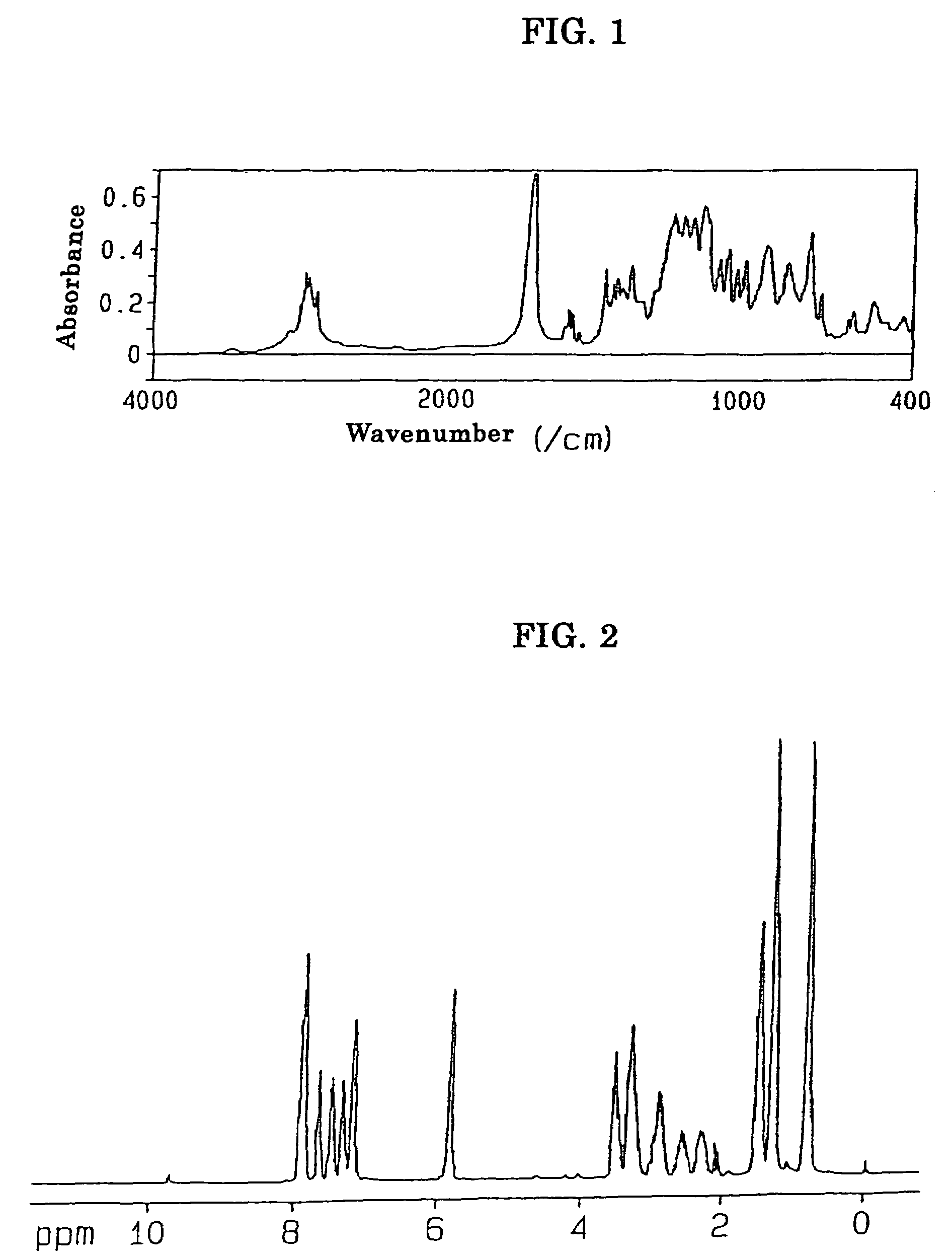Phosphorus-containing carboxylic acid derivatives process for preparations thereof and flame retardant
a carboxylic acid and phosphorus technology, applied in the field of phosphorus-containing carboxylic acid derivatives, can solve the problems of deterioration of stability and water resistivity, failure to maintain working effect, problem on external appearance, etc., and achieve excellent solubility in organic solvents and excellent characteristics.
- Summary
- Abstract
- Description
- Claims
- Application Information
AI Technical Summary
Benefits of technology
Problems solved by technology
Method used
Image
Examples
reference example 1
Synthesis of M-Acid by the Use of Acetonirile as the Solvent
[0180]A four-neck flask equipped with a reflux condenser, a stirrer and a thermometer was charged with 30.1 parts by weight of HCA, 19.9 parts by weight of itaconic acid and 50.0 parts by weight of acetonitrile, and the resultant mixture was reacted with one another at 81° C. for 4 hours under stirring. When the reaction liquid thus formed was cooled to room temperature, white crystal was precipitated and accordingly separated by filtration. When the white crystal thus obtained was dried with the use of a vacuum dryer under the conditions of 20 mmHg, 80° C. for one hour, there was obtained 44.7 g of a white crystal having a melting point in the range of 191 to 198° C. and an acid value of 171 g / mol. A measurement was made of 1H-NMR of the product with a result that peaks were confirmed at 7.27 to 8.15 ppm (m, H8), at 3.31 to 3.32 ppm (m, H1) and at 2.50 to 2.82 ppm (m, H2), and thus the structure of product represented by t...
reference example 2
Synthesis of M-Acid by the Use of Acetonirile and PMAc as the Solvents
[0182]A four-neck flask equipped with a reflux condenser, a stirrer and a thermometer was charged with 30.1 parts by weight of HCA, 19.9 parts by weight of itaconic acid, 20.0 parts by weight of acetonitrile and 30.0 parts by weight of PMAc (methoxypropyl acetate), and the resultant mixture was reacted with one another at 110° C. for 4 hours under stirring. When the reaction liquid thus formed was cooled to room temperature, white crystal was precipitated and accordingly separated by filtration. When the white crystal thus obtained was dried with the use of a vacuum dryer under the conditions of 20 mmHg, 80° C. for one hour, there was obtained 46.6 g of a white crystal having a melting point in the range of 196 to 198° C. and an acid value of 172 g / mol. A measurement was made of 1H-NMR of the product with a result that peaks were confirmed at 7.27 to 8.15 ppm (m, H8), at 3.31 to 3.32 ppm (m, H1) and at 2.50 to 2.8...
reference example 3
Synthesis of M-Acid by the Use of PMAc as the Solvents
[0184]A four-neck flask equipped with a reflux condenser, a stirrer and a thermometer was charged with 30.1 parts by weight of HCA, 19.9 parts by weight of itaconic acid and 30.0 parts by weight of PMAc (methoxypropyl acetate), and the resultant mixture was reacted with one another at 122° C. for 2 hours under stirring. At that time, white crystal was precipitated. Further stirring was continued for one hour, the reaction liquid thus formed was cooled to room temperature, and the white crystal was separated by filtration. The white crystal thus obtained in an amount of 20 parts by weight was dried with the use of a vacuum dryer under the conditions of 20 mmHg, 80° C. for one hour, there was obtained 48.4 g of a white crystal having a melting point in the range of 196 to 198° C. and an acid value of 172 g / mol. A measurement was made of 1H-NMR of the product with a result that peaks were confirmed at 7.27 to 8.15 ppm (m, H8), at 3....
PUM
| Property | Measurement | Unit |
|---|---|---|
| temperature | aaaaa | aaaaa |
| temperature | aaaaa | aaaaa |
| temperature | aaaaa | aaaaa |
Abstract
Description
Claims
Application Information
 Login to View More
Login to View More - R&D
- Intellectual Property
- Life Sciences
- Materials
- Tech Scout
- Unparalleled Data Quality
- Higher Quality Content
- 60% Fewer Hallucinations
Browse by: Latest US Patents, China's latest patents, Technical Efficacy Thesaurus, Application Domain, Technology Topic, Popular Technical Reports.
© 2025 PatSnap. All rights reserved.Legal|Privacy policy|Modern Slavery Act Transparency Statement|Sitemap|About US| Contact US: help@patsnap.com



